Getting a tooth pulled—whether a regular tooth or a wisdom tooth—isn’t just a simple in-and-out dental procedure. The real journey begins after the extraction, during recovery. Knowing what to do and what to avoid after tooth extraction is essential for proper healing, avoiding pain, and steering clear of serious complications like dry socket, infections, or prolonged bleeding.
In this guide, we’ll walk you through the top things to avoid after wisdom tooth extraction and general tooth removal, so you can heal faster, feel better, and get back to smiling with confidence. Also, don’t miss the comprehensive list of 50 soft foods to eat after tooth extraction.
Why Avoiding Certain Habits Post-Extraction Matters
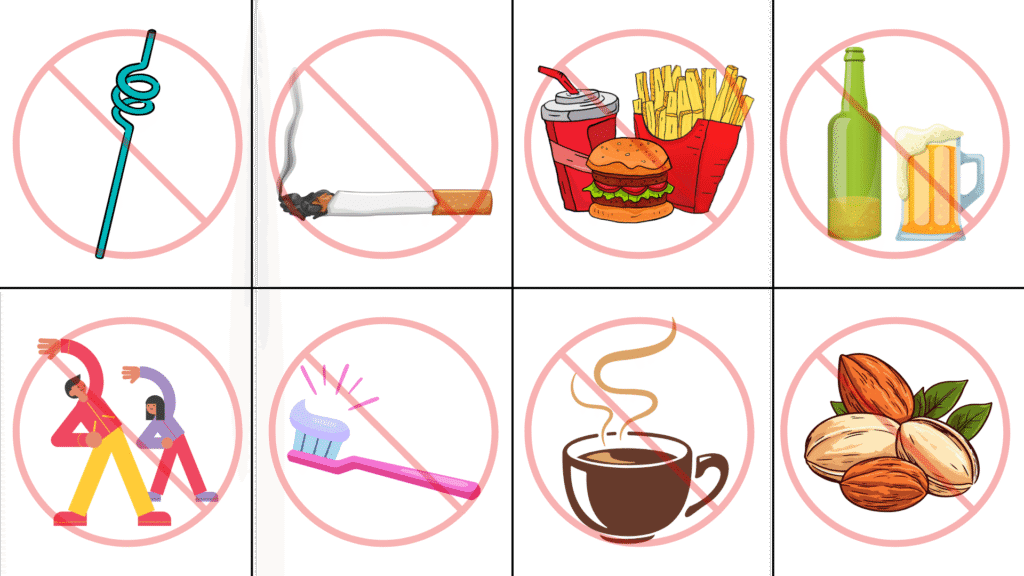
After a tooth is extracted, a blood clot forms in the socket—this clot is crucial for healing. If it becomes dislodged or doesn’t form properly, it can lead to a painful condition known as dry socket, which may require additional treatment and extend your healing time by several days or even weeks. That’s why avoiding certain activities isn’t just recommended—it’s necessary. Especially smoking after extraction of a tooth.
💡 The first 24 to 72 hours after a tooth extraction are the most critical for healing. Be extra careful during this period.
- 1. Do Not Use Straws or Suck on Anything
- 2. Avoid Smoking and Tobacco in Any Form
- 3. Stay Away From Hard, Crunchy, or Spicy Foods
- 4. Don’t Drink Alcohol
- 5. Refrain from Rinsing or Spitting Forcefully
- 6. Avoid Intense Physical Activity or Exercise
- 7. Don’t Touch the Site With Fingers or Tongue
- 8. Avoid Brushing the Extraction Site Directly
- 9. Skip Hot Drinks Like Coffee or Tea
- 10. Don’t Ignore Unusual Symptoms
- Common Questions About Tooth Extraction Aftercare
- Final Thoughts: Prioritize Healing for a Healthier Smile
1. Do Not Use Straws or Suck on Anything
Suction from sipping through a straw or smoking can disturb the healing clot and lead to dry socket. This includes:
- Drinking with a straw
- Smoking or vaping
- Sucking on candy or ice
🔴 Avoid for at least 7 days. Even one accidental sip through a straw can set your recovery back.
Recommended Guide: When Can I Eat Solid Food after Tooth Extraction?
2. Avoid Smoking and Tobacco in Any Form
Nicotine slows blood flow to the gums and delays healing. Worse, smoking increases the risk of infection and dry socket dramatically. Tobacco also contains chemicals that interfere with the body’s natural ability to regenerate tissue.
🟠 Avoid tobacco products for a minimum of 72 hours, but ideally for the full duration of healing (7–10 days).
💡 Consider using this recovery period as a chance to quit smoking for good—your mouth (and lungs) will thank you.
3. Stay Away From Hard, Crunchy, or Spicy Foods
Eating sharp or hard foods can irritate the extraction site, get stuck in the wound, or worse—open it. Spicy foods can also cause irritation or burning sensations. Read more about Things to Eat after Tooth Extraction.
Avoid foods like:
- Chips, crackers, and popcorn
- Nuts or seeds
- Spicy sauces and curries
✅ Opt for soft, cool, or lukewarm foods like mashed potatoes, yogurt, applesauce, or scrambled eggs during the first 5–7 days.
4. Don’t Drink Alcohol
Alcohol thins the blood, which can increase bleeding and slow healing. Plus, it can react poorly with painkillers or antibiotics prescribed post-surgery.
🔵 Avoid alcoholic drinks for at least 72 hours, or longer if you’re taking medication. Your dentist may advise a full week without alcohol.
5. Refrain from Rinsing or Spitting Forcefully
Vigorous rinsing or spitting can dislodge the clot and trigger dry socket. For the first 24 hours, don’t rinse or spit at all. After that, rinse gently with warm salt water—not mouthwash.
📌 Mix ½ teaspoon of salt with 1 cup of warm water and swish very gently 2–3 times a day starting from day two.
6. Avoid Intense Physical Activity or Exercise
Heavy lifting, running, or even bending over can raise blood pressure and potentially cause the extraction site to reopen.
🛑 Avoid activities such as:
- Gym workouts
- Jogging or brisk walking
- Sports or physical labor
🟢 Rest for at least 48 to 72 hours after the procedure. Then ease back into activity as guided by your dentist.
7. Don’t Touch the Site With Fingers or Tongue
It’s tempting—but don’t poke around with your tongue or fingers. This can:
- Dislodge the clot
- Introduce bacteria
- Irritate the area
Keep your hands clean and away from your mouth. Let your mouth heal without interference.
8. Avoid Brushing the Extraction Site Directly
Good oral hygiene is still important, but you must brush with care. Avoid brushing over the socket, especially in the first few days.
Do this instead:
- Use a soft-bristled toothbrush
- Gently brush the surrounding teeth
- Avoid commercial mouthwash for the first 2–3 days
💡 Chlorhexidine (prescribed by your dentist) may be used after a few days, but only if advised.
9. Skip Hot Drinks Like Coffee or Tea
Hot beverages can dissolve the healing clot and cause bleeding. They also may numb your sensitivity, leading to accidental burns.
🟠 Avoid hot tea, coffee, and soup for at least 48 hours. Choose lukewarm or cold options instead.
10. Don’t Ignore Unusual Symptoms
If you notice any of the following signs, don’t “wait and see”—call your dentist immediately:
- Severe pain after 3–4 days
- Foul odor or taste in the mouth
- Swelling that worsens after 48 hours
- Pus or white/yellow discharge
These may signal infection, dry socket, or another complication requiring professional treatment.
Common Questions About Tooth Extraction Aftercare
How Long Should I Wait Before Eating?
You can eat soft foods a few hours after the procedure, once the numbness wears off. Avoid chewing on the extraction side for at least 5 days.
Can I Sleep on My Side After Extraction?
It’s best to sleep with your head elevated (on your back) for at least the first night to reduce swelling and prevent bleeding.
What About Wisdom Tooth Extraction? Is It Different?
Yes, wisdom tooth extraction typically involves deeper sockets and longer healing times. You’ll need to follow these aftercare tips even more carefully and for a longer duration—typically 7 to 10 days.
How long does it take for the hole to close after a tooth extraction?
The socket typically starts to close within 7 to 10 days, but complete healing of the gum tissue can take up to 3 to 4 weeks. For wisdom tooth extractions, especially impacted ones, it may take longer. The bone underneath may continue healing for several months.
Can I brush my teeth the day after a tooth extraction?
Yes, you can gently brush your teeth the next day, but avoid the extraction site directly. Use a soft-bristled toothbrush and be cautious while rinsing. You should also skip commercial mouthwash and opt for salt water rinses starting 24 hours post-surgery.
Final Thoughts: Prioritize Healing for a Healthier Smile
Knowing the things to avoid after wisdom tooth extraction or regular tooth removal isn’t about being overly cautious—it’s about giving your body the best chance to heal quickly and comfortably. The habits you follow (or avoid) in the first few days make all the difference.
Be kind to yourself, follow your dentist’s guidance, and remember: temporary sacrifices now mean a healthy, pain-free smile tomorrow.
Disclaimer: The content provided in this article is for educational and informational purposes only. It does not substitute professional medical advice, diagnosis, or treatment. For guidance specific to your dental condition or recovery, please consult your dentist, oral surgeon, or licensed healthcare provider.

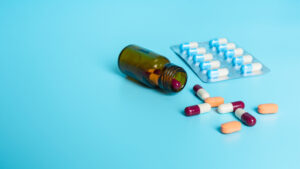
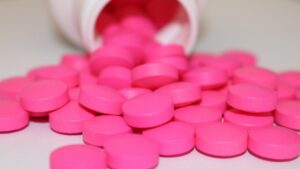


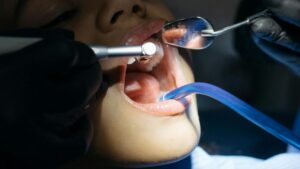


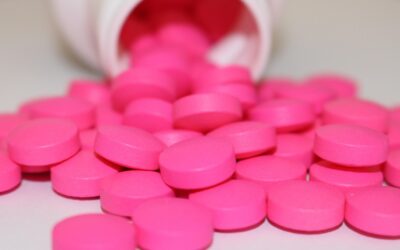

0 Comments